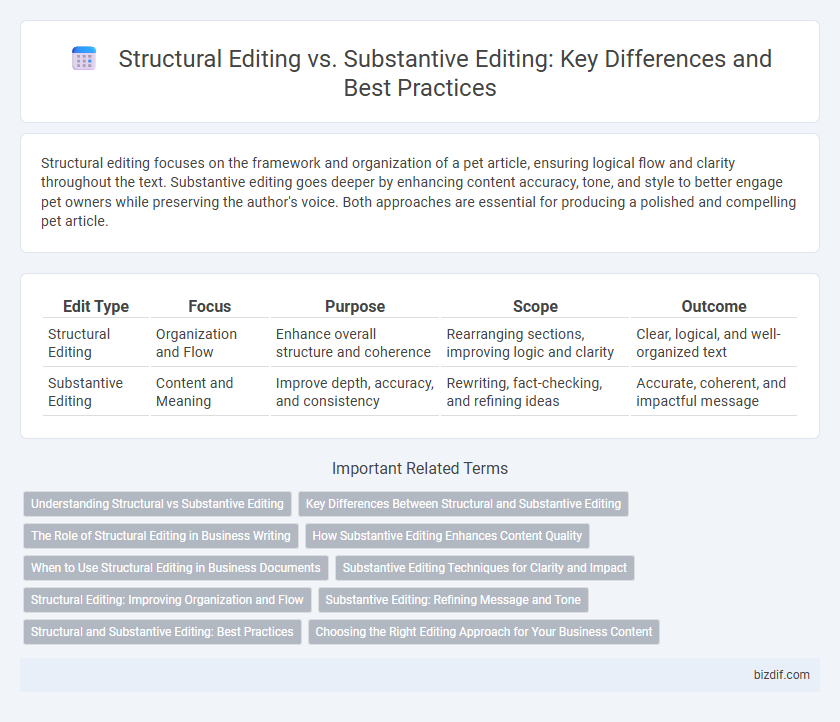Structural editing focuses on the framework and organization of a pet article, ensuring logical flow and clarity throughout the text. Substantive editing goes deeper by enhancing content accuracy, tone, and style to better engage pet owners while preserving the author's voice. Both approaches are essential for producing a polished and compelling pet article.
Table of Comparison
| Edit Type | Focus | Purpose | Scope | Outcome |
|---|---|---|---|---|
| Structural Editing | Organization and Flow | Enhance overall structure and coherence | Rearranging sections, improving logic and clarity | Clear, logical, and well-organized text |
| Substantive Editing | Content and Meaning | Improve depth, accuracy, and consistency | Rewriting, fact-checking, and refining ideas | Accurate, coherent, and impactful message |
Understanding Structural vs Substantive Editing
Structural editing focuses on the overall framework of a document, ensuring logical flow, clear organization, and coherent chapter transitions to improve readability and content hierarchy. Substantive editing delves deeper into the content quality, addressing issues like plot consistency, character development, factual accuracy, and thematic depth. Understanding structural vs substantive editing allows authors to identify whether their manuscript needs broad organizational improvements or detailed content refinement for effective communication.
Key Differences Between Structural and Substantive Editing
Structural editing focuses on the overall organization and flow of a manuscript, addressing issues like chapter arrangement, pacing, and narrative coherence. Substantive editing delves deeper into content accuracy, clarity, and consistency, often involving fact-checking and refining arguments or themes. Key differences include the scope of changes: structural editing reshapes the framework, while substantive editing enhances content quality and depth.
The Role of Structural Editing in Business Writing
Structural editing enhances business writing by organizing content for clarity, coherence, and logical flow, ensuring that key messages are effectively communicated to target audiences. It focuses on the overall framework, including headings, paragraph structure, and the alignment of ideas with business objectives. This type of editing improves readability and impact, facilitating better decision-making and stakeholder engagement.
How Substantive Editing Enhances Content Quality
Substantive editing improves content quality by addressing the core structure, clarity, and flow of the manuscript, ensuring ideas are logically organized and effectively communicated. This type of editing goes beyond surface-level corrections to refine arguments, enhance coherence, and eliminate redundancies, resulting in a more engaging and impactful narrative. By focusing on the writer's message and intent, substantive editing transforms raw content into polished, high-quality work that resonates with the target audience.
When to Use Structural Editing in Business Documents
Structural editing should be employed in business documents when the overall organization and flow of information hinder clarity or effectiveness, such as in reports, proposals, or strategic plans. This type of editing restructures sections and paragraphs to improve logical progression and coherence, ensuring the document meets its intended purpose. Early implementation of structural editing enhances readability and helps align the content with business goals before moving on to detailed language and style adjustments.
Substantive Editing Techniques for Clarity and Impact
Substantive editing techniques enhance clarity and impact by restructuring content to improve logical flow and coherence, ensuring each section supports the overall message effectively. This process involves evaluating paragraph organization, refining sentence construction, and clarifying ambiguous ideas to maintain reader engagement. Emphasizing tone consistency and purposeful word choice further strengthens the manuscript's persuasive power and readability.
Structural Editing: Improving Organization and Flow
Structural editing enhances a manuscript by reorganizing content to improve clarity, coherence, and logical progression. This process involves rearranging paragraphs, refining chapter sequences, and ensuring seamless transitions that strengthen the overall narrative structure. Prioritizing structural editing results in a more engaging and comprehensible text that effectively conveys the author's message.
Substantive Editing: Refining Message and Tone
Substantive editing enhances the clarity and impact of a manuscript by refining the message, tone, and overall structure to align with the author's intent and audience expectations. This editing process addresses deeper content issues such as consistency, pacing, and character development in fiction or argument strength in nonfiction. By focusing on these elements, substantive editing ensures that the final work communicates effectively and resonates with readers on a meaningful level.
Structural and Substantive Editing: Best Practices
Structural editing focuses on the organization and flow of content, ensuring logical progression and clarity by addressing plot structure, chapter arrangement, and pacing. Substantive editing dives deeper into content integrity, coherence, and style consistency, refining language, character development, and thematic elements for a polished manuscript. Best practices include detailed manuscript evaluation, collaborative author-editor communication, and iterative revision cycles to balance narrative structure with content depth effectively.
Choosing the Right Editing Approach for Your Business Content
Choosing the right editing approach for your business content depends on the document's purpose and complexity. Structural editing focuses on the overall organization, clarity, and flow, ensuring the content aligns with strategic goals and target audience needs. Substantive editing delves deeper into the content's accuracy, tone, and message consistency, making it ideal for technical reports, proposals, and brand-critical materials.
Structural Editing vs Substantive Editing Infographic

 bizdif.com
bizdif.com